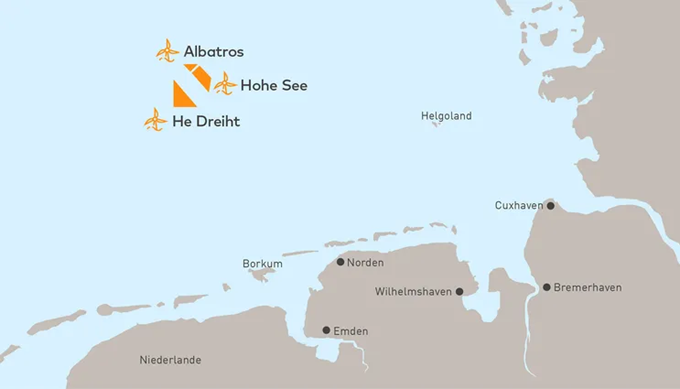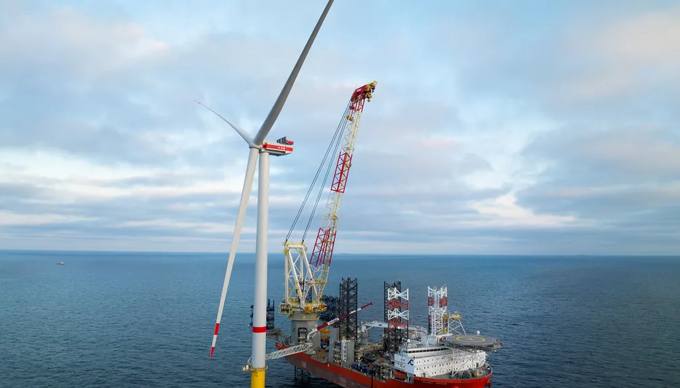
Map Location He Dreiht
It's turning – the Low German name of EnBW's third wind farm in the North Sea, He Dreiht, couldn't be more apt: By spring 2026, the 64 wind turbines with an installed capacity of 960 MW will be connected to the grid around 90 kilometers northwest of the island of Borkum and 110 kilometers west of Heligoland. As one of the first subsidy-free offshore wind farms, it will almost double EnBW's offshore portfolio from its current 976 MW in one fell swoop.
Following the commissioning of the North Sea wind farms EnBW Hohe See and Albatros, the He Dreiht wind farm is once again operating on a completely different scale: For the Vestas V236-15 turbines, each with an output of 15 MW, this is the first commercial deployment of this type of turbine. EnBW is thus once again taking on a pioneering role on the high seas. With a total installed capacity of 960 MW, He Dreiht is also one of the largest energy transition projects in Europe and will theoretically supply 1.1 million households with renewable energy.
At a hub height of 142 meters, the rotor, with a diameter of 236 meters, covers an area of 43,742 square meters with one rotation – equivalent to the area of six football fields. The German-Dutch grid operator TenneT will ensure the connection to the power grid with an offshore converter station and two high-voltage direct current export cables. The cables will be laid 120 kilometers underwater and 110 kilometers onshore.

Offshore technology made in Europe
The components for He Dreiht are produced in various countries. Project management is handled from Hamburg, and the service station is located in Emden.
Subsidization-free wind farm – how does it work?
As one of the first subsidy-free wind farms, He Dreiht does not receive feed-in tariffs under the Renewable Energy Sources Act. As a kind of replacement for traditional EEG subsidies, EnBW relies on PPAs (Power Purchase Agreements). These are developing into a key instrument of the energy transition: They are long-term purchase agreements between generators and often large-scale industrial customers. These corporate PPAs enable the farm operator to generate calculable income, and electricity consumers hedge against market price fluctuations through energy supplies from renewable energy plants. For the green energy generated via He Dreiht, there are already secured long-term power purchase agreements with well-known partners such as the operating company of Frankfurt Airport (Fraport) with 85 MW, Evonik (150 MW), Salzgitter (50 MW), Bosch (50 MW), Deutsche Bahn (20 MW), Telekom subsidiary PASM (100 MW) and SHS-Stahl-Holding Saar (50 MW).
Cooperation partners on board
The investment volume for He Dreiht is approximately 2.4 billion euros. To finance this major project, EnBW has secured long-term financing of 600 million euros from the European Investment Bank, one of the world's largest financiers of climate protection and ecological projects.
In addition, through the sale of a minority stake of 49.9 percent to a consortium of Allianz Capital Partners on behalf of the Allianz companies, AIP and Norges Bank, highly professional and experienced partners are already on board before construction begins.
Concerns of nature and the environment
When planning and implementing an offshore wind farm, we feel a special obligation to the environment and nature, ensuring that our projects are in harmony with their needs. This is especially important in a sensitive habitat such as the German North Sea. Therefore, an environmental impact assessment was conducted for the He Dreiht offshore wind farm as part of the approval process.
The numbers at a glance
| Installed capacity | 960 MW |
| Annual yield | 3.6 billion kWh |
| Turbines | 64 Vestas V236-15 |
| Foundations | Monopiles |
| Hub height | 142 meters |
| Rotor diameter | 236 meters |
| Rotor area | 43,742 square meters = approx. 6 football fields |
| Average wind speed | 10.4 m/s |
| Water depth | 37.7 meters – 40.6 meters |
KeyFacts Energy: EnBW Germany country profile l KeyFacts Energy: Projects Database
 KEYFACT Energy
KEYFACT Energy